Feldkirch, Austria. I’d never heard of it and had no plans to visit. I ended up in this sub-Alpine village for one reason only; it was the easiest and least expensive way to visit Liechtenstein. Not knowing how long that would take I booked two nights, but by the end of the first day, I’d seen more than half of Liechtenstein. As I rolled into bed that night back in Feldkirch, I wondered what I would do with a full extra day.
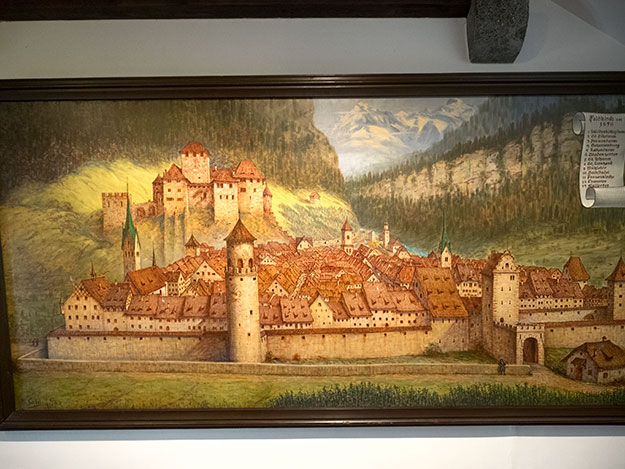
The next morning I woke to brilliant sunshine. The surrounding hills sparkled with clean green pines and cottony clouds scooted through crisp blue skies. I grabbed my camera and headed out to explore. At the pretty Town Hall I learned that Feldkirch, Austria was established by Count Hugo I of Montfort around 1200. Each of the 50 farms at the base of the mighty Schattenburg Mountain was required to deliver one cartload of manure each year to ensure the Montfort vineyards thrived. Thus the Count’s list of suppliers – the Mistrodel – (literally the “manure list”), became the town’s first census of residents. It was just the first of many intriguing stories I would hear about Feldkirch.
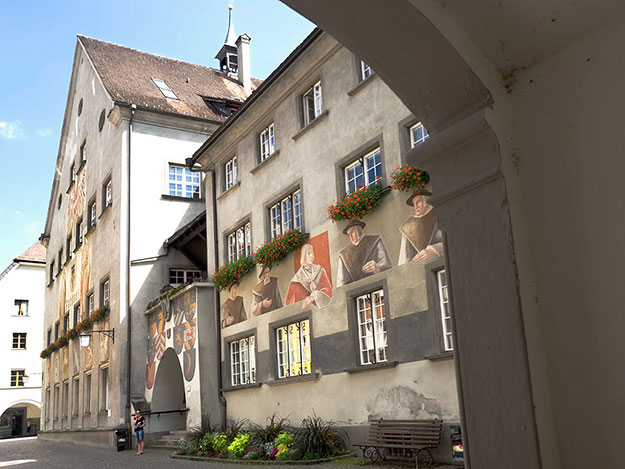
The town flourished and by 1218 the Montforts had built the first hospital, as well as St. John’s Church and Monastery. This is the very church where the devil is said to have appeared against a backdrop of lightning and sulphur vapor one night, to drag the alchemist Faust through the skylight to hell. According to the legend, the skylight must forever remain open, since any new pane of glass would shatter.
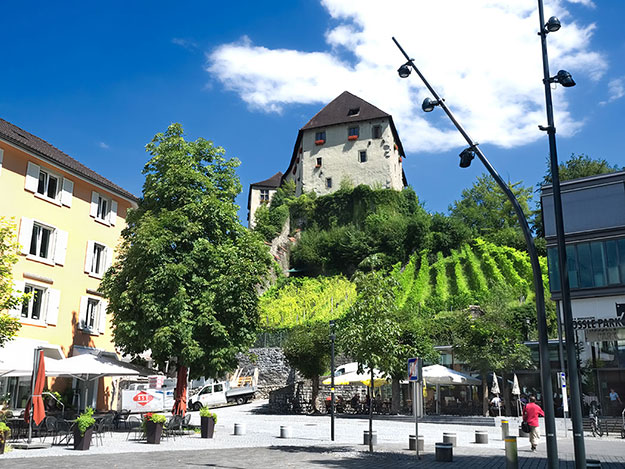
The first part of what would become the mighty Schattenberg Castle was completed in 1265 atop the mount. Today the restored castle houses a fine restaurant that offers impressive views over the town and valley. But residents also insist it is haunted. Long ago, Schattenburg was home to Ida, the most beautiful maiden in the land. One day a traveling troubadour came through town and captured her heart. When the musician moved on, he left behind a sad and very pregnant Ida. Afraid of the scandal that would come of a bastard child, she killed the infant when it was born and crept down the beggars’ staircase to wash the blood off her hands. Locals claim her sorrowful ghost follows the same path every Saturday night.
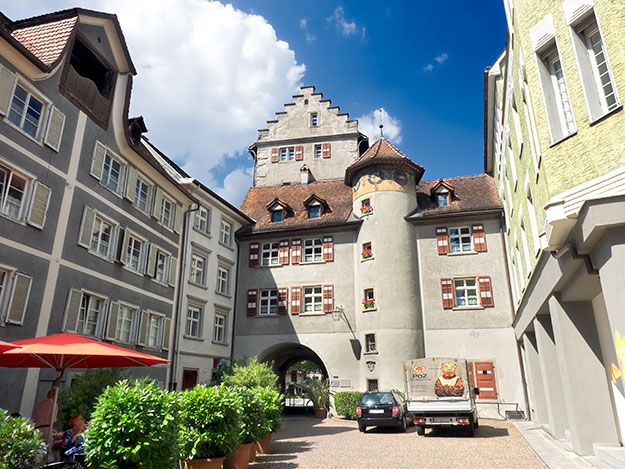
As the town grew prosperous, thick stone walls with high turrets were constructed around it for protection. Wealthy citizens built palaces and mansions within the strong fortifications, in architectural styles ranging from Gothic to Baroque. One in particular, the Lingg Inn, is renowned for the paintings of naked Bacchus figures on its facade. The chubby-cheeked cherubs were revealed in their nakedness during a restoration in 1969. Originally painted in 1888 as a protest against the restrictive laws of the day, they created such an uproar that the owner was forced to have clothes painted on them.
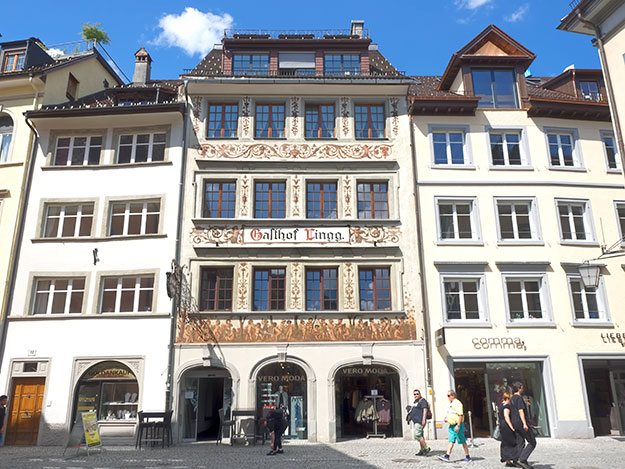
Though only small portions of the old city wall remain, four of the magnificent towers and the two original town gates still stand. Most significant among them is the Katzenturm, named for the big cannon that once occupied its top floor. During medieval times, the cannon was replaced with the Pummerin, an 8.5 ton bell that still strikes thunderous tones on special occasions. Each peal recalls the time in March 1799, when Napoleon’s troops massed outside the town walls in preparation for attack. In a ploy aimed at fooling the citizens of Feldkirch into believing they were safe, the troops suddenly withdrew on Easter Sunday morning. Led by the bell in the Katzenturn, all the bells rang out in joy. The French, mistaking it as a call to muster additional forces, fled in the face of what they assumed must be superior power.

Feldkirch has been witness to scores of historical events. The stately Voralberg State Conservatory, built in 1900, began life as the Jesuit college of Stella Matutina. Its most famous student was Arthur Conan Doyle, who attended in 1875 to improve his German. During his time at the institute he wrote many articles for the school – who knows, maybe the seed of his Sherlock Holmes character was even sown in Feldkirch.
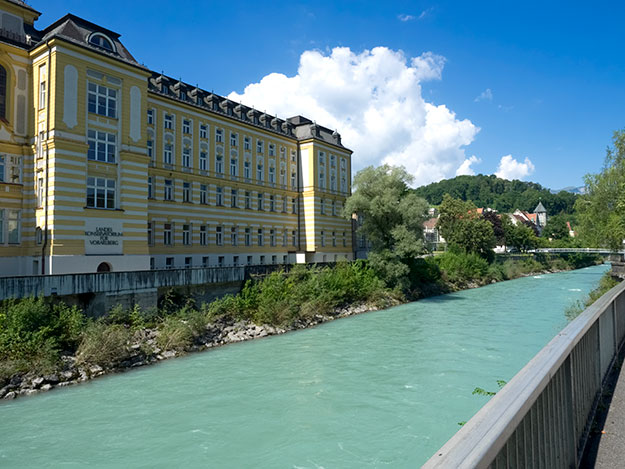
Fleeing World War I, author James Joyce escaped to neutral Switzerland from the Feldkirch train station in 1915. Many years after the end of the war he returned for a long stay. Every evening he stood at the station and waved to trains headed for Switzerland, paying homage to his successful escape. “Over there, on the tracks – that is where the fate of Ulysses was decided,” he said.
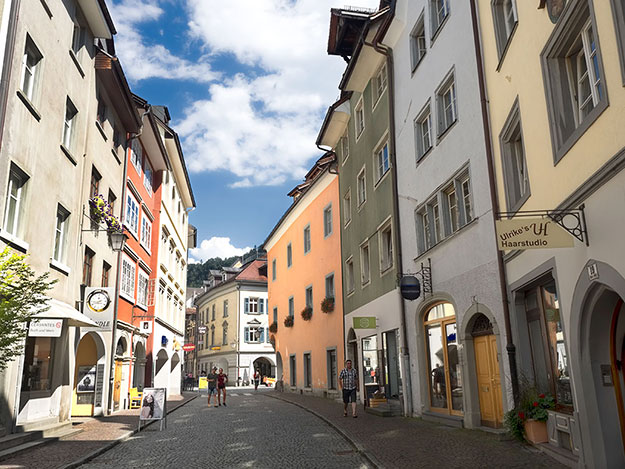
Even today, the town continues to play a part in modern mythology. In the 2008 classic “Quantum of Solace,” James Bond pursued a villain through Marktgasse, the main street in the historic center. The chapel at the old Capuchin Monastery attracts headache sufferers, who claim that praying to Saint Fidelis cures their malady. The monk was so over-zealous in his attempts to convert the local farmers that they murdered him in 1622. His body was interred at the cathedral in Chur, Switzerland, but his head remained in the Capuchin Church in Feldkirch. Each year on April 24, the anniversary of his death, it is paraded through the streets.
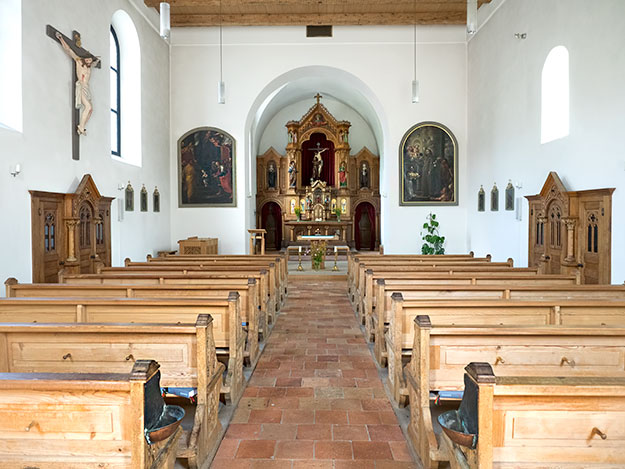
Feldkirch is such a treasure trove of exquisitely preserved buildings and churches that I can hardly believe it is not better known. Certainly, it is it an ideal base for visiting Liechtenstein. But Feldkirch itself is well worth a visit, to see its delightful old town and hear the many legends that have been handed down from generation to generation.
Author’s Note: I stayed at Hotel Garni Bären, a wonderfully historic guesthouse located just a two-minute walk from the historic center. If you make your reservation through clicking on the above Booking.com link, I will earn a small commission, which helps keep this blog free for you to read.

Just read the story of Feldkirch to Hubert Sperandio as he was driving us back to Brisbane after competing in a golf competition in Bundaberg, Qld., Australia. Hubert was born in Feldkirch in 1935 as was his mother Maria Anderle in 1906. Hubert migrated in 1956 first to Dunedin, New Zealand then to Australia and presently lives in Brisbane. He enjoyed listening to the history of Feldkirch some of which he had forgotten over time. Very well written and informative.
Thank you so much Carole. I really liked Feldkirch.
love the name of your site. I too leave all of the material madness in America a few months a year and just go somewhere….then somewhere else….all unplanned. No regrets. I do visit Feldkirche often because my husbands corporate office is in Schlinns.
So I drop him off at work, then hit the wide open roads! Lord the places I have ended up! Ancient vehicle tunnels clinging to mountains, I helped a farmer catch a few ponies (thank god I was raised with horses lol)and in return made life long friends…and the farmer was nice too…kidding. My point is, I wish people would just throw iteneraries out the window and stay away from top tourist attractions. Get lost. I will say that the town Blidenz is worth getting lost in in the chilly time of year. It is literally a Willy Wonka experience. The entire village smells like chocolate due to the Milka Factory in the center of town. I would love to see your photography and share mine…question: have you been to Croatia? I would like to go there next…if you have any advice that would be great! Cheers!
Hi Erin: I love Croatia. So much to see and do there. From the capital city (Zagreb) to the Dalmation coast, it’s spectacular.
I visited Feldkirch few weeks ago from 3rd Nov 2017 for 3 nights. I wasnt sure what i expect when i arrived but found that it was a beautiful place with natural surroundings. I took a half day to Vaduz and its very easy to catch a bus from Feldkirch HBF. The Old town of Feldkirch is very charming and loved the castle on the hill and the walk along the river. Feldkirch is also a great base if you want to visit Bregenz and Lindau in Germany which is only about 35mins away. I was very satisfied to visit one of Europe’s hidden gems that no one hears of. Another plus was the absence of crowds so i was able to enjoy the spoils of Feldkirch’s old town without the swarms of tourists. Plus the natural setting of the mountains made Feldkirch more beautiful. i would highly recommend it to anyone wanting to visit.
Hi Peter: Totally agree with your assessment. Feldkirch is one of those undiscovered gems that we all search for.
My fraternal grandparents are from Feldkirch. My grandmother Marie Kreuzer emigrated from Feldkirch in 1906 arriving in New York on the ship Kaiser Wilhelm II.
My great grandfather Martin Nasal 1854 – 1919 arrived in the US prior 1870.
I have original post cards from Feldkirch dated 1900. I visited with my son 3 years ago. The central part of the town today looks very similar to the black and white postal cards of 1905.
Beautiful place.
Hi Ron: Thanks so much for your comment. How fascinating that you could see a photo of the place from which your family emigrated. It was a truly wonderful town, which I found quite by accident, and I count it a fortunate accident indeed. So happy you had a chance to see it for yourself.
Another hidden gem – you seem to have the knack of finding them – good on ya!
I too read your blog posts with interest each time they are in my email box. Thanks for the info and I too just may come up with a visit there.
You’d love it, Irene. It’s a real gem.
Your very interesting description of Feldkirch has made me want to learn more about the town. As usual, your details are much better qualified than any wikipedia! I look forward for your holeinthedonut in my E-mail, and open it as fast as I can.
Just out of curiosity, Conan Doyle based his Sherlock Holmes stories on his forensic teacher, Joseph Bell (1837-1911) to whom he was \”secretary-assistant\’\”, in the years that he was a medical student at the University of Edinburgh. As a doctor myself (orthopaedic surgeon), I had the opportunity in visiting The Royal College of Surgeons (Edinburgh) where both had been members, and learned what I mentioned above. C. Doyle seemed to be highly inspired by Professor Bell\’s skill in observation of a human being and his deductions and conclusions. Undoubtedly a very interesting man to follow and write about, and Conan Doyle did that brilliantly.
Hi Walter. I know we’ve corresponded via email since you left this comment, but I wanted to reply here as well to say how very much I appreciated your comment. It renewed my faith that there are people out there in cyberspace who actually read and enjoy what I write. Thank you SO much for being a loyal follower of my blog.
I so want to visit Austria — and your photos here of Feldkirch are making get much closer to the top of my bucket list! Nice to meet you face-to-face in Manila at TBEX Asia.
Hi Linda: It was great to meet you as well. I learned so much from your course. The only way it might have been better is if we’d had time to get into the marketing side of ebook publication. But maybe that’s an idea for a future workshop?
I agree on the marketing end of things — I really should be doing a book or course somewhere on it. 🙂 It’s something my students often ask about.
What a gorgeous place … might have to visit it when I’m in Europe next year!
Hope you get a chance to stop, if even for a couple of days. It’s a wonderful little town.
I visited Feldkirch with a friend I was staying with in St Gallen and it was a real surprise for us. One of the many cities in Europe that you never hear that is interesting to visit.
Hi James: Yes! I always love it when I come across those hidden gems that no one seems to know about. Hope you are doing well.
All the way from India, I suddenly found myself in Feldkirck. It was Saturday 02/06,and the world had descended on Feldkirck.
Imagine my delight, Feldkirck was celebrating its 800th anniversary.
The town was decked up with colourful flags, the 2 central streets abuzz with throngs dressed in medieval style, as farmers, carpenters, artisans each running his medieval trade or craft. Others were dressed as burghers, lord and ladies.
It was market day as well. There was such a medieval spirit created by street plays, medieval duelling, music, clowns etc and all who served the visitors , whether in the market or the restaurants or the chemists were dressed to take us back into Feldkirch’s medieval past.
It was such an interesting experience I returned to Lucerne to google it and stumbled upon your piece.
All that info about Aurthur Conon Doyle and James Joyce makes Feldkirch a place worth visiting again.
Passing through Liechtenstein has fired my imagination.
So next time I’m in Switzerland, Vaduz beckons too.
Hi Monica: Thanks for telling me (and my readers) of your experience in Feldkirch, and for confirming that others find it as interesting as I did. I suspect you’d like Vaduz as well, though given a choice between the two, I’d still pick Feldkirch.